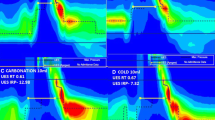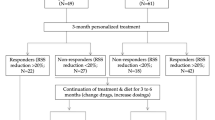Abstract
Muscle tension dysphonia (MTD) is the pathological condition in which excessive tension of the (para)laryngeal musculature leads to a disturbed voice. This study was developed to investigate if differences in pressure in the upper esophageal sphincter (UES) were present in patients with MTD in comparison with normal speakers. Concurrently, all patients were screened for gastroesophageal reflux disease (GERD) as an associated cause or aggravating factor in MTD. The study’s design was a prospective case-control study. Fourteen patients with MTD (mean age = 40.2 years, range = 22–62 years) and 14 adult controls (mean age = 33.9 years, range = 23–58 years) were studied. A water-perfusion assembly with 22 sensors was positioned to record pressures during phonation. The mean values of the phonation pressures at the UES were measured. All patients underwent a dual-probe 24-h ambulatory pH impedance in order to measure the pH and the height of the refluxes from the lower esophageal sphincter to the hypopharynx. There were no significant differences in the UES pressures of patients with MTD compared to those of normal speakers during phonation tasks and reading. Two patients were identified with GERD. In these patients the refluxate reached the UES but this did not influence the UES pressures. We conclude that this study was not able to detect differences in phonation-induced UES pressures between patients with MTD and normal speakers using a standard water-perfusion high-resolution manometry assembly. Future investigation should be focused on developing probes with closely spaced sensors in the hypopharynx and the esophagus in order to investigate if differences in UES pressures in these study populations are present.

Similar content being viewed by others
References
Rubin J, Sataloff RT, Korovin g. Diagnosis and treatment of voice disorders. 3rd ed. San Diego: Plural Publishing; 2005.
Morrison MD, Rammage LA. Muscle misuse voice disorders: description and classification. Acta Otolaryngol. 1993;113:428–34.
Morrison MD, Nichol H, Rammage LA. Diagnostic criteria in functional dysphonia. Laryngoscope. 1986;96:1–8.
Sama A, Carding PN, Price S, Kelly P, Wilson JA. The clinical features of functional dysphonia. Laryngoscope. 2001;111:458–63.
Perera L, Hofmann C, Tatro L, Chai K, Kuribayashi S, Lawal A, Shaker R. Manometric evidence for a phonation-induced UES contractile reflex. Am J Physiol Gastrointest Liver Physiol. 2008;294:885–91.
Koufman JA. The otolaryngologic manifestations of gastroesophageal reflux diseases (GERD): a clinical investigation of 225 patients using ambulatory 24-hour pH monitoring and an experimental investigation of the role of acid and pepsin in the development of laryngeal injury. Laryngoscope. 1991;101(4 Pt 2 Suppl 53):1–78.
Belafsky PC, Postma GN, Koufman JA. Validity and reliability of the reflux symptom index (RSI). J Voice. 2002;16:274–7.
Koufman JA, Amin MR, Panetti M. Prevalence of reflux in 113 consecutive patients with laryngeal and voice disorders. Otolaryngol Head Neck Surg. 2000;123:385–8.
Altman KW, Lazarus C. Current and emerging concepts in muscle tension dysphonia: a 30-month review. J Voice. 2005;19:261–7.
Torrico S, Kern M, Aslam M, Narayanan S, Kannappan A, Ren J, Sui Z, Hofman C, Shaker R. Upper esophageal sphincter function during gastroesophageal reflux events revisited. Am J Physiol Gastrointest Liver Physiol. 2000;279:262–7.
Vilkman E, Hurme P, Korkko P. External laryngeal frame function in voice production revisited: a review. J Voice. 1996;10:78–92.
Angsuwarangsee T, Morrison M. Extrinsic laryngeal muscular tension in patients with voice disorders. J Voice. 2002;16:333–43.
Van Lierde K, Dhaeseleer E, Wuyts F, Claeys S. The treatment of muscle tension dysphonia: comparison of two treatment techniques by means of an objective multiparameter approach. J Voice. 2010;24:294–301.
Van Lierde K, Bernart L, De Bodt M, Van Cauwenberghe P. Outcome of manual voice therapy in four Dutch adults with persistent moderate to severe vocal hyperfunction: a pilot study. J Voice. 2004;18:467–74.
Wuyts F, De Bodt M, Molenberghs G, Heylen L, Millet B, Van Lierde K, Raes J, Van de Heyning P. The Dysphonia Severity Index: an objective measure of vocal quality based on a multiparameter approach. J Speech Lang Hear Res. 2000;43:796–809.
Rosen CA, Lee AS, Osborne J, Zullo T, Murry T. Development and validation of the voice handicap index-10. Laryngoscope. 2004;114:1549–56.
Mesallam TA, Stemple JC, Sobeih TM, Elluru RG. Reflux symptom index versus reflux finding score. Ann Otol Rhinol Laryngol. 2007;116:436–40.
Hakkesteegt MM, Brocaar MP, Mulder P, Feenstra L. The interobserver and test-retest variability of the Dysphonia Severity Index. Folia Phoniatr Logop. 2008;60:86–90.
Remacle M. The contribution of videolaryngostroboscopy in daily ENT practice. Acta Otorhinolaryngol Belg. 1996;50:265–83.
Poburka BJ. A new stroboscopy rating form. J Voice. 1999;13:403–13.
Richter JE, DeMeester TR, Wu WC. Normal 24-hr ambulatory esophageal pH values. Influence of study center, pH electrode and gender. Dig Dis Sci. 1992;37:849–56.
Gill C, Morrison MD. Esophagolaryngeal reflex in a porcine animal model. J Otolaryngol. 1998;27:76–80.
Bove M, Cange L, Mansson I. 24-h pharyngeal pH monitoring in healthy volunteers: a normative study. Scand J Gastroenterol. 2000;3:234–41.
Milstein CF, Hicks DM, Abelson TI, Richter JE, Vaezi MF. Prevalence of laryngeal irritation signs associated with reflux in asymptomatic volunteers: impact of endoscopic technique (rigid vs. flexible laryngoscope). Laryngoscope. 2005;115:2256–61.
Van Houtte E, Van Lierde K, Claeys S. Pathophysiology and treatment of muscle tension dysphonia: a review of the current knowledge. J Voice. 2011;25:202–7.
Conflict of interest
None.
Author information
Authors and Affiliations
Corresponding author
Rights and permissions
About this article
Cite this article
Van Houtte, E., Van Lierde, K., D’haeseleer, E. et al. UES Pressure During Phonation Using High-resolution Manometry and 24-h Dual-probe pH-metry in Patients with Muscle Tension Dysphonia. Dysphagia 27, 198–209 (2012). https://doi.org/10.1007/s00455-011-9354-0
Received:
Accepted:
Published:
Issue Date:
DOI: https://doi.org/10.1007/s00455-011-9354-0




